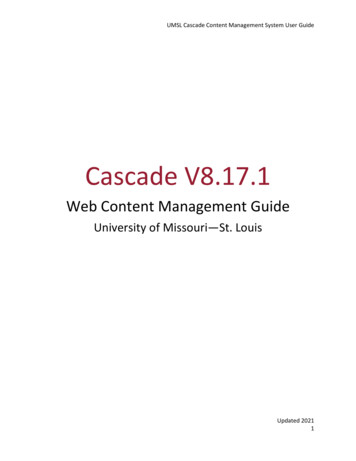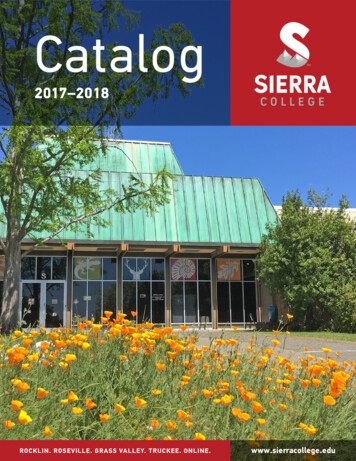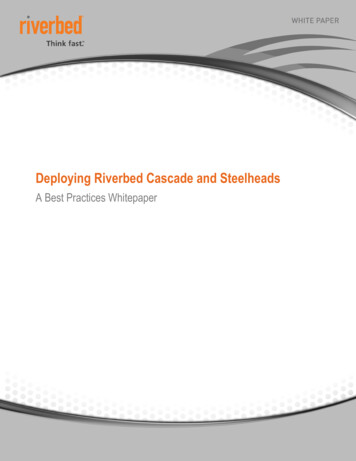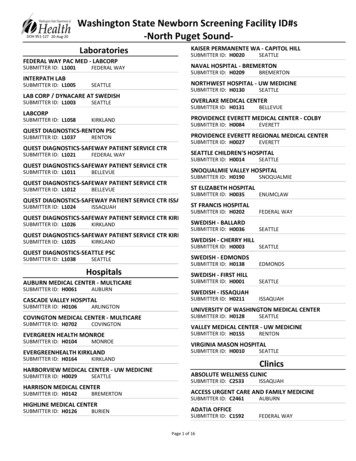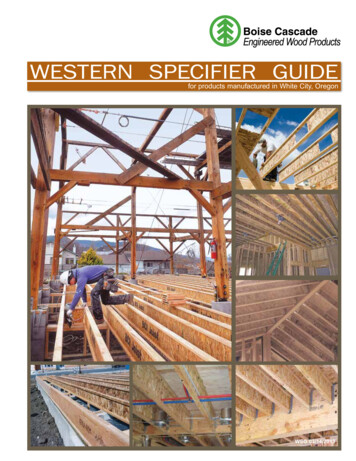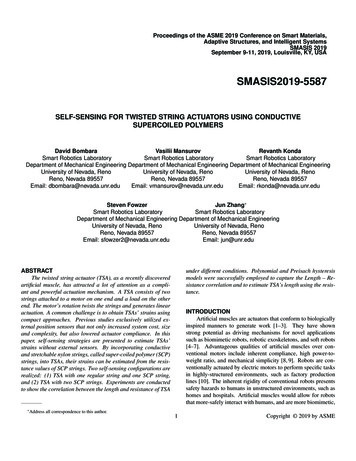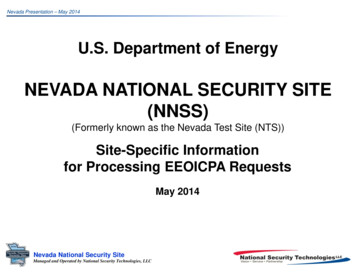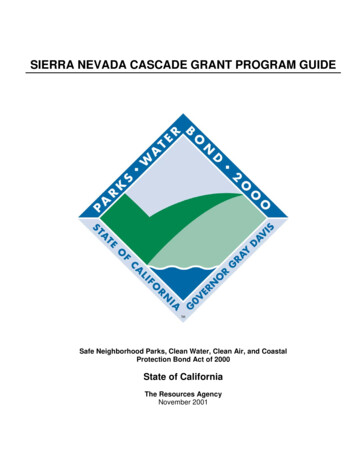
Transcription
SIERRA NEVADA CASCADE GRANT PROGRAM GUIDESafe Neighborhood Parks, Clean Water, Clean Air, and CoastalProtection Bond Act of 2000State of CaliforniaThe Resources AgencyNovember 2001
TABLE OF CONTENTSSection/PageI.DEFINITIONS 1II.SIERRA NEVADA CASCADE GRANT PROGRAMIntroductionProgram IntentAmount of Funds AvailableState Administrative CostsGeographic Area Covered by the ProgramEligible ApplicantsProject Eligibility44444556III.IMPORTANT POINTS9IV.PROJECT APPLICATION AND SELECTION PROCESSHow to ApplyWhat to Submit101011V.PROJECT CRITERIANeedAccess and LocationOrganizational CapabilityProject ReadinessYouth Employment Benefit131315151616VI.GRANT ADMINISTRATION PROCESSGrant ProcessTimeframesChanges to Approved ProjectEligible CostsPayment of Grant FundsAdvance PaymentsFinal Payment RequestSite Visits and Final InspectionProject WithdrawalLoss of Funding1616171718191920202020VII.STATE AUDIT AND ACCOUNTING REQUIREMENTSAccounting RequirementsRecord Retention212121i
VIII.APPENDICESAppendix A – Application FormAppendix B – Sample ResolutionAppendix C – Land Tenure RequirementsAppendix D – Sign GuidelinesAppendix E – Cost Estimate for Development ProjectsAppendix F – Land Acquisition Information and Schedule of Estimated CostsAppendix G – Payment Request FormAppendix H – Project Completion PacketAppendix I – Map of Geographic Area of ProgramAppendix J – Payee Data Recordii22242729343639425152
INQUIRIESDirect all inquiries, correspondence, and grant applications to:Grants AdministratorThe Resources AgencySierra Nevada Cascade Grants Program1416 Ninth Street, Room 1311Sacramento, CA 95814Phone: (916) 653-5656FAX : (916) 653-8102The deadline for applications and proposals is February 1, 2002.Applications submitted by mail must be received on or before the deadline. Handdelivered applications will be accepted no later than 4:00 PM of the deadline workday.iii
I. DEFINITIONSUnless otherwise stated, the terms used in this Grant Guide shall have thefollowing meanings:“Acquisition” means to obtain from a willing seller fee interest or any other interest,including easements and development rights, in real property.“Agency” means the Resources Agency of the State of California.“Agreement” means a contractual arrangement between the Agency and Granteespecifying the payment of funds by the Agency for the performance of specific Projectobjectives within a specific Project Performance Period by the Grantee.“Applicant” means an organization requesting funding from a program administered by theAgency.“Application” means the individual application form and supporting documentation requiredby a particular grant program as a prerequisite to execution of an Agreement for thatprogram.“Appropriation” means a budget authorization from a specific fund to a specific agency orprogram to make expenditures or incur obligations for a specific purpose and period oftime.“Bioengineering” means the use of horticultural and landscape planting techniques withliving materials, in conjunction with grading, earth moving and conventional soil stabilizationstructures, to produce a self-repairing, low-cost composite bank or channel.“Bond Act” ” means the Safe Neighborhood Parks, Clean Water, Clean Air, and CoastalProtection Bond Act of 2000.“CEQA” means the California Environmental Quality Act, Public Resources Code Section21000 et. seq.; Title 14, California Code of Regulations, Section 15000 et. seq.“Competitive” means vying against another or others for position or status based uponrelative project merits or benefits.“Contractor” means any entity that has been selected by the Grantee to perform Projectwork.“Development” means improvements to real property by construction of new facilities orrenovation or additions to existing facilities.1
“District” means: Any regional park district, regional park and open-space District or regional openspace District formed under Article 3 (commencing with Section 5500) of Chapter 3of the Public Resources Code Any recreation and park District formed under Chapter 4 (commencing with Section5780) of the Public Resources Code or an authority formed under Public ResourcesCode, Division 26 (commencing with Section 35100) Any District that is authorized to provide park, recreational, or open-space services,or a combination of those services, except a school District“Enhancement” means to modify current conditions, and may be used to describe a projectthat would result in a natural resource, cultural, or historic site, recreational area, or existingfacility realizing desired improvements while considering the protection of the naturalenvironment. It is distinguishable from “restoration” in that it does not imply merely a returnto natural conditions, but may include the provision of recreation or other aspects that werenot originally part of the features.“Grants Administrator” means an employee of the Resources Agency, who acts as liaisonwith the Grantees and administers Bond Act grants.“Grantee” means an Applicant that has an agreement for grant funding with the Agency.“In-Kind” means those funds and/or donations, which may be from a non-state source andwhich may include local or private funds, as well as materials and services, whether fromvolunteers or paid consideration.“Joint Powers Agency (JPA)”, for purposes of this grant program, means local agenciesformed under state law that allow two or more such agencies to combine efforts and exerciseauthority specifically for park purposes. Joint Powers Agencies function as legally separategovernment entities with their own governing boards.“Local Agency” means a local governmental jurisdiction with a range of authority or control.“Nonprofit organization” means any private, nonprofit organization which qualifies forexempt status under Section 501 (c) (3) of the United States Internal Revenue Code of1986, and has among its principal charitable purposes the preservation or enhancement ofland for scientific, historic, educational, recreational, scenic or open-space values, theprotection of the natural environment, or the preservation and enhancement of fisheriesand wildlife or their habitat.“Nonstructural” refers to measures that solve flooding or erosion problems withoutphysically changing the dimensions of a waterway. This may include floodplain zoning,land acquisition, flood insurance, watershed management, debris removal, and floodproofing of existing structures by elevating or building a berm around them, but does notinclude constructing storage reservoirs or lining channels.2
“Program” means the Sierra Nevada Cascade Grant Program.“Project” means the acquisition, development, restoration, enhancement or other activity tobe accomplished with grant funds.“Project Performance Period” means the timeframe during which the Grant funds areavailable and the Project must be completed, billed, and paid.“Project Scope” means a complete description of objectives and activities or work to beaccomplished during the course of the Project.“Rehabilitation” means the act of putting something back or reinstating its original conditionor “near” original condition or position.“Relocation Procedures” means that the Applicant must comply with the requirements ofthe State Relocation Act, Government Code Section 7260 et.seq., when displacing aperson or business by the Project. Note that relocation costs are allowable for Projects thatdisplace persons or businesses.“Restoration” means the process of reproducing, re-establishing or rehabilitating a naturalarea or a cultural or historic site that has deteriorated due to either natural or humancauses.“Riparian” means related to or on the banks of rivers, streams, wetlands, marshes or otherwater bodies.“Secretary” means the Secretary of the Resources Agency.“Stable” and “Stabilize” refer to the state or process of bringing a channel to a condition ofequilibrium in which the dimensions and gradient are appropriately matched to thewatershed and the runoff of water and sediment, with the objective to have a selfmaintaining system.“State Agency” means a governmental jurisdiction, department, or board of the State ofCalifornia with a range of authority or control.“Tenure” means the applicant owns the project land or has other long-term interest with thelandowner that is satisfactory to the Agency, as defined in Appendix D.“Trailhead and Trailside Facilities” include, but are not limited to parking, utilities,restrooms, bridges, draining structures, fencing and interpretive and informational signs,exhibit and brochure shelters and related improvements.3
II. SIERRA NEVADA CASCADE GRANT PROGRAMIntroductionThis procedural guide contains application and administration information for the SierraNevada Cascade Grant Program. A total of 3.302,225 million is available for grants forthis Program with the passage of the Safe Neighborhood Parks, Clean Water, Clean Air,and Coastal Protection Bond Act of 2000 (Proposition 12). A variety of projects may besupported by this funding.Program IntentThe Sierra Nevada Cascade Grant Program is intended to “assist local governments,agencies, districts, and non-profit organizations, working in collaboration with those localgovernments, agencies, districts,” and federally recognized California Indian tribes, “to plan,create and conserve the Sierra - Cascade natural ecosystem”.Grant funds are awarded competitively for all of the following projects: “The acquisition and restoration of riparian habitat in accordance with Sections7048 and 78682.2 of the Water Code to improve water quality, and to protect,restore, or rehabilitate watersheds, streams wetlands, or other aquatic habitat. Capital improvement projects that provide park and recreational opportunities. Access to trails and public lands in accordance with Article 6 (commencing withSection 5070) of Chapter 1 of Division 5. Acquisition of park lands or recreational facilities.”Source: Public Resources Code, Section 5096.347Total Funds Available for Grants 3,302,225.00.State Administrative CostsThe State costs of administering the Bond Act shall be paid out of the Bond proceeds.These costs shall be shared proportionately by each program funded through this BondAct. This amount has already been deducted from the total funds available for grants.4
Geographic Area Covered by the ProgramThe Sierra Nevada Cascade Program includes those portions of the following counties “thatare located in the mountains, the foothills, and the area adjacent to the geologic formationsof the Sierra Nevada and the Cascade mountain ranges”:AlpineAmadorButteCalaverasEl Dorado amaTuolumneTulareYubaThe region is defined as the areas bounded on the east by the California Nevadaborder south from the Oregon border to its intersection with the crest of the White/InyoRanges.It continues south along that mountain crest to its intersection with State Highway 190,then southwest along Highway 190 to its intersection with Highway 395 at Olancha.The boundary continues south on Highway 395 to the intersection of Highway 14, thensouth along Highway 14 to the intersection with the Sierra Nevada Ecological Unit(EU) [as defined by the US Forest Service map California Vegetation by WHRClassification, August 1994] continuing to its junction with Highway 58.The boundary continues along Highway 58 west to its intersection with Sierra NevadaEU.It follows north along the western boundary of that EU to its intersection with thewestern boundary of the Cascade EU.It continues north along the western boundary of the Cascade EU to the Pit River armof Shasta Lake, west to the junction of Interstate 5.The boundary continues north along Interstate 5 to the Oregon border and east alongthe California Oregon border line. (Reference map Appendix I.)Note: Communities that are bisected by the boundaries are fully included in thegeographic area.Eligible ApplicantsThe following entities are eligible to apply for these program funds: Cities Counties Districts (see definitions) Local Agencies formed for park purposes pursuant to a joint powers agreementbetween two or more local entities, except a school district Other Districts that are authorized to provide park, recreational, or open-spaceservices, or a combination of those services, except a school district Federally recognized California Indian Tribes Nonprofit organizations (see definitions). Nonprofit applicants must have agovernment agency as a cosponsor5
PROJECT ELIGIBILITYRivers & StreamProjectsFunds may be usedfor any of thefollowing:1. Enhancement, acquisition, or2.3.4.5.restoration of riparian orriverine habitats or otherlands in close proximity torivers, streams, wetlands, orother aquatic habitatProtection or restoration ofwatersheds, streams,wetlands, or other aquatichabitatProjects to maintain orenhance the environmentalcharacteristics of a stream orrestore a stream to a morenaturally functioning state aspart of a flood management orerosion control effortRivers and streams trailprojectsRiver parkway projectsTrailProjects1.Enhancement orrestoration of existingrecreational trails,trailhead and trailsidefacilities2. Construction,development, orrestoration of trailside andtrailhead facilities and traillinkages or corridors thatsupport small connectionswithin existing trailsystems3. Acquisition of easementsor fee simple title toproperty for recreationaltrail linkages or corridorsthat support smallconnections withinexisting trail systems4. Educational orinterpretive nature trailsnot to exceed one mile inlength6Capital ImprovementProjects1.Enhancement of publicaccess to or use ofnatural areas, openspace, or naturalresource-basedrecreational sites via theconstruction, alteration,renovation, or extensionof physical improvements2. Modification of existingstructures includingchanges to the function,layout, capacity or qualityof a facility that enhancesthe structure’sfunctionality for naturalresources-basedrecreational opportunities3. Expansion of thedesigned level of servicesof a facility or improvedarea4. Expansion of the diversityof available s1.Acquisitions whichenhance ecologicaldiversity, threatenedand endangeredspecies habitat, orareas of geological orscenic value2. Acquisitions thatsupport recreationalor interpretive uses orland that provides foreducational and/orinterpretive usesNOTE: Sites have greatersignificance than others ifthey contribute to abroader plan or programthat helps promote theresolution of a largerresource conflict or havea significant cost tobenefit ratio
EXAMPLES OF ELIGIBLE PROJECTSRivers & StreamProjects Acquire and develop river parkwaysAcquire or enhance significant riparian or riverine fish andwildlife habitat or restore degraded habitat. Sites havegreater significance than others if they contain or couldsupport more of the following factors: Wintering, breeding or migratory habitat Rare species or habitats Outstanding examples of species or habitats Essential habitat linkages Buffer zones Species or habitat that are experiencingsignificant declines or threats throughout theirdistribution Species with highly restricted distributions withinthe region or state Lands that are critical for successfullyimplementing local, regional, and/or stateconservation plansAcquire land to provide public access to rivers, streams,or river parkwaysAcquire land to increase the size and quality of existingriparian habitat, river parkways or other open spaceareas along rivers or streamsDevelop, improve or enhance trails, trailhead or trailsidefacilities along rivers, streams and/or river parkways forwalking, cycling and equestrian purposesClear debris from stream channels and perform erosioncontrol and bank stabilization workProvide riverfront parks to serve population centerslacking park areasDevelop new trails that link existing river or stream trailsTrailProjects Development of traillinkages, trailhead ortrailside facilities thatmeet an identifiablerecreational need orthat provide recreationopportunities notcurrently availableRestoration orenhancement of trails,trailhead or trailsidefacilities that are nolonger fully serviceableor that will provideexpanded or additionalrecreation opportunitiesImprovements to trails,trailhead or trailsidefacilities that willprovide expanded useby persons withdisabilities or othergroups7Capital ImprovementProjects ParksPicnic areasRiver or lake accessFishing and raftingaccess areasScenic andinterpretative vistasOpen space accessVisitor centersParking lots for anyof these facilitiesAcquisitionProjects Property thatprovides linkages orexpands wildlifecorridors betweenother public landsLand that expandsor complementsexisting park landsor existing trailsystemsAreas that containunique naturalfeatures and/or oneor more threatenedor endangeredplants or animalsAcquisition of naturalresource-basedrecreation facilities,such as camp sites
EXAMPLES OF INELIGIBLE PROJECTSRivers & StreamProjects Exclusivelyeducational projectsExclusively planningprojects without adefined and certainimplementationcommitmentOperations andmaintenance projectsProjects with norelation to a river orstream or other waterbodiesProjects located onschool properties notopen to the generalpublic and designedsolely for schoolstudentsTrailProjects Capital ImprovementProjectsMaster planning for trail developmentHighway beautification and parking for other thanrecreation purposesOperations and maintenance projectsProposals exclusively for purchase and lease ofrecreational trail construction and maintenanceequipmentConstruction of new recreational trails or acquisition ofeasements and fee simple title to property forrecreational trails or trail corridors that are not smallconnections within existing trail systemsProjects with no public accessEducational programs to promote safety andenvironmental protectionUpgrading, expanding or otherwise facilitating motorizeduse or access to trails predominantly used by nonmotorized trail usersConstruction of recreational trail links on Bureau of LandManagement or National Forest System lands formotorized use unless such lands:1. have been allocated for uses other thanwilderness by an approved agency resourcemanagement plan or have been released touses other than wilderness by an Act ofCongress, and2. such construction is otherwise consistent withthe management direction in such approvedland and resource management plan8 Indoor recreationalfacilitiesBall fieldsSwimming poolsNon-natural resourcebased activitiesOperations andmaintenance projectsAcquisitionProjects Properties wherethere is no willingsellerAcquisitions thatwould raiseenvironmentaljustice concernsProperties thatcannot be acquiredat fair market valueNon-naturalresource-basedrecreational facilities,including swimmingpools, basketballcourts, ball fields,etc.
III. IMPORTANT POINTSThe applicant should consider the following important points when applying for andadministering the Sierra Nevada Cascade Grant Program funds: Grant funds are not available for expenditure until they are appropriated inthe State budget and there is a fully executed Agreement between theAgency and the Grantee. Projects awarded funding must have a signed agreement by September 3,2002. Applicants shall submit an individual Application form for each eligibleproject. All projects shall be in compliance with the California EnvironmentalQuality Act, Division 13 (commencing with Section 21000). Evidence ofcompleted CEQA must be submitted by July 1, 2002. The Grantee is expected to complete the project and submit alldocumentation by May 3, 2004. Extensions may be requested in advanceand will be considered in the event of circumstances beyond the control ofthe Grantee. The Grantee shall provide for public access in accordance with the intentand provisions of the enabling legislation and/or program. Public accessmay vary depending on the nature of the project. All real property shall be acquired from a willing seller and in compliancewith current laws governing relocation and acquisition of real property bypublic agencies. Disbursement of grant funds for property acquisition willbe subject to prior approval of fair market value by the State Departmentof General Services. Applicants shall comply with all applicable current laws and regulationsaffecting Development Projects, including, but not limited to legalrequirements for construction contracts, building codes, health and safetycodes, and disabled access laws. For Development projects, Applicants must own the land, or hold a leaseor other long-term interest in the land that is satisfactory to the Agency.(Reference Appendix C for land tenure requirements). Grantee agrees to use the property developed with grant monies underthis Program only for the purposes for which the State grant monies wererequested, and no other use of the areas shall be permitted except byspecific act of the Legislature.9
Grantee agrees to maintain and operate the property developed for aperiod commensurate with the Land Tenure requirements (Appendix C).Grantee may be excused from its obligations for operation andmaintenance of the Project site only upon the written approval of theAgency for good cause. “Good cause” includes, but is not limited to,natural disasters that destroy the Project improvements and render theProject obsolete or impracticable to rebuild. Grantees shall post signs acknowledging the source of funds pursuant toguidelines established for this Grant Program (Reference Appendix D). Direct charges, which include costs related to construction management,are eligible. Indirect costs are not eligible.IV. PROJECT APPLICATION AND SELECTION PROCESSHow to Apply1.Read the application materials carefully and decide if your project appears likelyto qualify for a grant.2.Determine the interest of any partners or cosponsors that would broaden theimpact of the grant.3.Determine if there are other sources of funding.4.Obtain the required signed resolution from your governing body and the landtenure documents for the project site.5.Assemble all application documents.6.Have designated representatives sign the original application.7.Submit 8 copies of the completed application including all required documents.One copy must be unbound and single-sided.Only complete applications received by the deadline will be evaluated and consideredfor funding.Separate applications must be submitted for each project. A "master" application containingseveral projects at more than one site is not acceptable.10
The deadline for applications and proposals is February 1, 2002.Applications submitted by mail must be received on or before the deadline.Hand-delivered applications will be accepted no later than 4:00 PM of the deadlineworkday.Submit to the:Grants AdministratorSierra Nevada Cascade ProgramThe Resources Agency1416 Ninth Street, Room 1311Sacramento, CA 95814What to SubmitA complete application consists of one original and 7 copies of each of the items listedbelow:1. Application Form (Reference Appendix A)2. Project Proposal Narrative –The information provided in the Project ProposalNarrative will be used by the State to evaluate competing grants. The narrativeshould include a complete description of the project, the full project scope, location,purpose, the amount of grant funds being requested, and how grant funds will beused, and address all of the applicable areas of the grant criteria (Section V). Thenarrative should be in 12-point font (Arial or Times New Roman); we suggest nomore than 5 pages.3. Authorizing Signed Resolution from governing body (Reference Appendix B).4. Environmental Compliance – Applicants are encouraged to certify CEQAcompliance at the time the grant application is submitted. Include an EnvironmentalImpact Report or Negative Declaration along with a response from the StateClearinghouse and a copy of the Notice of Determination filed with, and stamped by,the County Clerk; or if applicable, a copy of the Notice of Exemption stamped by theCounty Clerk if the project is categorically exempt. If the Project is on Federal land,also provide evidence of NEPA compliance.Projects that have not received CEQA certification are eligible for consideration.However, documentation of environmental compliance must be submitted by July 1,2002. Indicate in the grant application the current status of the CEQA review.5. Project location map (city or county) with enough detail to allow a person unfamiliarwith the area to locate the project. Also include other maps or aerial photographsthat demonstrate the need for the Project. Maps or images must fit an 8 ½ X 11binder.11
6. Evidence of adequate land tenure for development projects (lease, joint powersagreement, etc.). See Appendix C for property held in less than fee title.7. Site plan (Development Projects). Include a site plan showing facilities to bedeveloped and exterior boundaries of the project site. Plan should be specificenough to allow someone unfamiliar with the project to visualize it in detail.8. Cost Estimate (Development Projects). Provide a detailed project budget estimatereflecting all costs associated with the project and specifically designate costs to becovered by the grant request and costs to be covered by other sources. The budgetshould quantify costs for planning and design, ground area of work, acquisitionscosts (if applicable), labor, materials and equipment requirements, signage, anddisplay the total project budget in relation to the total amount of the grant request.(Reference format in Appendix E.)9. Signage Compliance: Provide documentation that sign requirements for the projectwill be met. Indicate on site plans the locations where signs will be posted. Ensurethat all cost estimates reflect signage costs.10. Land Acquisition Information and Schedule of Estimated Costs (AcquisitionProjects). Complete the acquisition form shown in Appendix F.11. A project time line, including a quarterly expenditure plan.12. Permits required. List all permits that may be required for the project. Grantee willneed to certify that all required permits have been received before constructionfunds will be released.13. All agreements associated with project operation and maintenance. Draftagreements or other written evidence will be accepted.14. Labeled photographs of the project site. Color photocopies are acceptable. Submita maximum of 5 photos no larger than 81/2” X 11”.15. Articles of Incorporation, if nonprofit applicant.16. Payee Data Record, if nonprofit applicant (Appendix J).17. Additional Grants: List all other grants applied for including the grant programname, the administering agency, the amount of the request and the date, orexpected date, of the award/action. Also list all grants that have been awarded forthe property/project.12
V. PROJECT CRITERIAEach grant application will be reviewed by the Resources Agency’s Sierra Nevada CascadeGrant Committee to determine whether it is complete and meets the eligibility requirements.Eligible applications will then be read, compared and ranked on a relative scale based on theinformation provided.Project Proposal NarrativeA Project Proposal Narrative must be submitted as part of the Project Application Package. Theinformation in the narrative will be used by the Committee to evaluate competing grantproposals.Project Proposal CriteriaPlease respond to each of the following five major headings. Projects will be scored using thecriteria values shown below:A.B.C.D.E.Need for ProjectAccess and LocationOrganizational CapabilityProject ReadinessYouth Employment Benefit(50 points)(20 points)(15 points)(15 points)( 5 points)A. Need For ProjectDiscuss the need for your project based on the following questions. Use the chart below todetermine which questions are specific to your project.TYPE of PROJECTRiparian or Aquatic Habitat Restoration orAcquisition per Water Code 78682.2Flood and Erosion Control per Water Code 7048(Urban Streams Program)Access to Trails & Public LandsANSWER QUESTIONS #4, 2, 3, andif Acquisition, also answer 6through 101, 2, 3,5 andif Acquisition, also answer 6through 101, 2, 3if Acquisition, also answer 6through 10Capital Improvement that provide Park andRecreational Opportunities1, 2, 3Acquisition of Park Lands & Recreational Facilities1, 2, 3 and 6 through 101. What is the specific need or opportunity addressed by this Project?a) What is the current situation relative to the need?b) What will the situation be after the Project is completed?c) What will happen if the Project is not completed?d) What is unique or special about this resource or the recreational experience it will provide?13
2. Describe any other public benefits that will result from this Project such as aestheticbenefits; increased public access to rivers, streams, or other bodies of water, recreationalor open space areas or trails; flood or erosion control, or benefits to water quality,watersheds or streams, wetlands or other aquatic habitats; recreational opportunities,economic enhancements and/or ecological enhancements.3. Describe any future actions needed beyond the scope of this project to fully address yourgoals. What are your plans for funding sources?4. a) What are the specific biological or physical elements targeted by the conservationaction? (If species are among the targeted elements, identify the species by scientificname. If plant communities are among the targeted elements, identify the communityusing Jepson, Holland or some other recognized plant community classification. Ifhabitats are among the targeted elements, identify the habitats using the Wildlife HabitatRelationship, National Wetlands Inventory, or some other recognized and appropriateclassification.)b) How much riparian/aquatic habitat wi
The Sierra Nevada Cascade Grant Program is intended to "assist local governments, agencies, districts, and non-profit organizations, working in collaboration with those local governments, agencies, districts," and federally recognized California Indian tribes, "to plan, create and conserve the Sierra - Cascade natural ecosystem".

